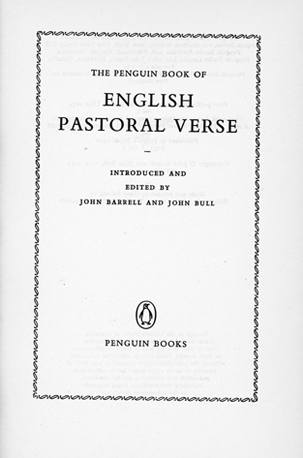Exercise 4: A Short Poem in an Edited Collection of Poems
Citing a poem from an edited collection of poems takes a very similar form to citing an article in an edited collection: Poet's name, 'Title of Short Poem', in Title:Subtitle, ed. by Editor's Name (Place: Publisher, Date), pp. page span of poem (l. or ll. number of specific line(s) cited). Note the different ending: when quoting from a poem you typically cite not the page number(s) (p. or pp.) but the line numbers (l. for one line, ll. for multiple lines). For instance:
Robert Herrick, 'His Farewell to Sack', in Ben Jonson and the Cavalier Poets, ed. by Hugh Maclean (London: Norton, 1974), pp. 110-12 (ll. 29-30).
Exercise
The poem:

Which is contained in the following book:


(If the editors' names are unclear in the left-hand image, you'll find them listed more clearly in the enlarged version of the right-hand image.)
For this exercise, imagine you wanted to cite line 28 of this poem.
Correct footnote:
Your footnote above, should look like this:William Wordsworth, 'The Last of the Flock', in *The Penguin Book of English Pastoral Verse*, ed. by John Barrell and John Bull (Harmondsworth: Penguin Books, 1982), pp. 454-58 (l. 28).In your own work, the same footnote would look like this:
William Wordsworth, 'The Last of the Flock', in The Penguin Book of English Pastoral Verse, ed. by John Barrell and John Bull (Harmondsworth: Penguin Books, 1982), pp. 454-58 (l. 28).
Comment:
While this exercise has focused on short poems, the same format is used to cite short essays, plays, or stories in larger collections. For example, you would reference this Toby Litt short story as follows:
Toby Litt, 'The Puritans', in All Hail the New Puritans, ed. by Nicholas Blincoe and Matt Thorne (London: Fourth Estate, 2001), pp. 165-90 (p. 180).
For essays and short stories you should provide page numbers. For poems you should provide line numbers. Where a poem is split into larger subsections (i.e. into individual 'books') this number should be given in small capital roman numerals,[1] and a full stop should separate the book number from the line number (e.g. you would cite line 2 of the fifth book of Paradise Lost in the form v.2). For plays, act numbers should appear in small capital roman numerals, while scene and line numbers should be given in arabic numerals, with a full stop separating each part (e.g. you would cite lines 3-5 of the second scene of the fourth act of The Tempest in the form iv.2.3-5).
Where a substantial work previously published under its own name appears in a larger collection, you should give the work's title in italics rather than enclosing it in single quotation marks. For example:
Geoffrey Chaucer, Troilus and Criseyde, in The Riverside Chaucer, ed. by Larry D. Benson, 3rd edn (Oxford: Oxford University Press, 1988), pp. 473-585 (iii.1156-61).
[1] A Note on Small Caps: Small caps are uppercase characters that are set at the same height as lowercase characters. You can turn lowercase letters into small capitals in the main 'Font' option of most Word Processing software. The MHRA recommends the use of small caps for subdivisions of larger works (so acts of a play, books of a poem, volumes of a multi-volume work, etc.). As small caps are somewhat fiddly, for the purposes of the examples in the 'Advanced Tutorial', we expect you to simply use uppercase roman numerals to indicate volume numbers, etc.

